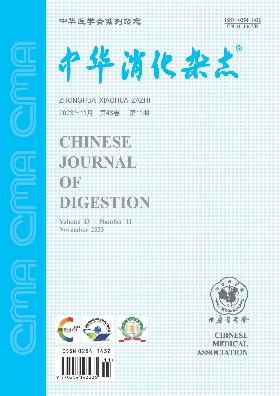Value of serum high density lipoprotein-cholesterol in risk assessment of non-alcoholic fatty liver disease
引用次数: 0
Abstract
Objective To investigate the value of high density lipoprotein-cholesterol (HDL-C) in the diagnosis and risk assessment of non-alcoholic fatty liver disease (NAFLD). Methods A cross-sectional study and multistage stratified random sampling method were performed in epidemiological survey. According to inclusion and exclusion criteria, a total of 3 312 individuals were enrolled and divided into NAFLD group (913 cases) and non-NAFLD group (2 399 cases). The serum lipid levels were compared between the two groups. Receiver operating characteristic (ROC) curve was performed to evaluate the value of HDL-C in the diagnosis of NAFLD. The binary logistic regression models were established based on HDL-C level.The differences in liver function indexes were compared among the research objects with different HDL-C levels.T test and Mann-Whitney U test were performed for statistical analysis. Results The serum levels of total cholesterol, triglyceride and low density lipoprotein-cholesterol (LDL-C) of NAFLD group were all higher than those of non-NAFLD group ((5.24±0.92) mmol/L vs.(4.98±0.92) mmol/L, (1.95±1.41) mmol/L vs.(1.13±0.68) mmol/L, (3.31±0.84) mmol/L vs.(3.09±0.84) mmol/L), and the differences were statistically significant (t=-7.29, -22.38 and -6.84, all P<0.01). However the serum HDL-C level of NAFLD group was lower than that of non-NAFLD group((1.30±0.33) mmol/L vs.(1.64±0.40) mmol/L), and the difference was statistically significant (t=24.93, P<0.01). The incidence of hypercholesterolemia, hypertriglyceridemia, hypo-high-density lipoprotein cholesterolemia and hyper-low-density lipoprotein cholesterolemia of NAFLD group was 48.0%(438/913), 44.8%(409/913), 31.0%(283/913) and 82.8%(756/913), respectively, which were significantly higher than that of non-NAFLD group (36.8%, 882/2 399; 13.2%, 317/2 399; 10.5%, 251/2 399; 71.8%, 1 723/2 399), and the differences were statistically significant (χ2=34.65, 385.43, 206.18 and 42.37, all P<0.01). Using the cut-off values of HDL-C≤1.66 mmol/L in female and≤1.33 mmol/L in male, the area under curve (AUC) values for NAFLD diagnosis were 0.720(95% confidence interval (CI) 0.693 to 0.747) and 0.708 (95%CI 0.679 to 0.737), respectively, the sensitivity was 79.1% and 76.6%, and the specificity was 55.0%and 54.6%. The results of binary logistic regression models based on HDL-C level indicated that prevalence of NAFLD in female with low HDL-C was 4.584 times (95%CI 3.530 to 5.940, P<0.01) higher than that in female with high HDL-C; the prevalence of NAFLD in male with low HDL-C was 3.898 times (95%CI 3.020 to 5.030, P<0.01) higher than that of male with high HDL-C. The alanine aminotransferase (ALT), aspartate transaminase (AST), gamma glutamyl transpeptidase (GGT) and alkaline phosphatase (ALP) levels of low HDL-C group were all higher than those of high HDL-C group (20.10 U/L, 14.40 U/L to 29.40 U/L vs. 16.80 U/L, 12.70 U/L to 23.00 U/L; 19.20 U/L, 16.00 U/L to 23.70 U/L vs. 19.00 U/L, 16.00 U/L to 22.17 U/L; 22.00 U/L, 14.00 U/L to 34.00 U/L vs. 15.00 U/L, 11.00 U/L to 23.00 U/L and 71.00 U/L, 59.00 U/L to 85.00 U/L vs. 66.00 U/L, 55.00 U/L to 82.00 U/L), and the differences were statistically significant (Z=-10.53, -2.20, -14.19 and -5.87, all P<0.05). Conclusion The serum HDL-C level is negatively correlated with the risk of NAFLD level, and the NAFLD risk of individuals with low HDL-C level is significantly higher than individuals with high HDL-C level. Key words: Cholesterol, HDL; Non-alcoholic fatty liver disease; Risk factors; Anti-inflammation effects血清高密度脂蛋白-胆固醇在非酒精性脂肪肝风险评估中的价值
目的探讨高密度脂蛋白-胆固醇(HDL-C)在非酒精性脂肪性肝病(NAFLD)诊断及风险评估中的价值。方法采用横断面调查和多阶段分层随机抽样的方法进行流行病学调查。根据纳入和排除标准,共纳入3 312例患者,分为NAFLD组(913例)和非NAFLD组(2 399例)。比较两组患者血脂水平。采用受试者工作特征曲线(Receiver operating characteristic, ROC)评价HDL-C在NAFLD诊断中的价值。基于HDL-C水平建立二元logistic回归模型。比较不同HDL-C水平的研究对象肝功能指标的差异。采用T检验和Mann-Whitney U检验进行统计学分析。结果NAFLD组血清总胆固醇、甘油三酯、低密度脂蛋白-胆固醇(LDL-C)水平均高于非NAFLD组((5.24±0.92)mmol/L比(4.98±0.92)mmol/L,(1.95±1.41)mmol/L比(1.13±0.68)mmol/L,(3.31±0.84)mmol/L比(3.09±0.84)mmol/L),差异均有统计学意义(t=-7.29、-22.38、-6.84,均P<0.01)。NAFLD组血清HDL-C水平低于非NAFLD组((1.30±0.33)mmol/L∶(1.64±0.40)mmol/L),差异有统计学意义(t=24.93, P<0.01)。NAFLD组高胆固醇血症、高甘油三酯血症、低高密度脂蛋白胆固醇血症和超低密度脂蛋白胆固醇血症的发生率分别为48.0%(438/913)、44.8%(409/913)、31.0%(283/913)和82.8%(756/913),显著高于非NAFLD组(36.8%,882/2 399;13.2%, 317/2 399;10.5%, 251/2 399;71.8%(1 723/2 399),差异有统计学意义(χ2=34.65、385.43、206.18、42.37,P均<0.01)。以女性HDL-C≤1.66 mmol/L和男性≤1.33 mmol/L为临界值,诊断NAFLD的曲线下面积(AUC)分别为0.720(95%可信区间(CI) 0.693 ~ 0.747)和0.708(95%可信区间(CI) 0.679 ~ 0.737),敏感性为79.1%和76.6%,特异性为55.0%和54.6%。基于HDL-C水平的二元logistic回归模型结果显示,低HDL-C女性NAFLD患病率是高HDL-C女性的4.584倍(95%CI 3.530 ~ 5.940, P<0.01);低HDL-C男性NAFLD患病率是高HDL-C男性的3.898倍(95%CI 3.020 ~ 5.030, P<0.01)。低HDL-C组丙氨酸转氨酶(ALT)、天冬氨酸转氨酶(AST)、谷氨酰转肽酶(GGT)和碱性磷酸酶(ALP)水平均高于高HDL-C组(20.10 U/L、14.40 U/L ~ 29.40 U/L vs. 16.80 U/L、12.70 U/L ~ 23.00 U/L;19.20 U/L、16.00 U/L至23.70 U/L vs. 19.00 U/L、16.00 U/L至22.17 U/L;22.00 U/L、14.00 U/L ~ 34.00 U/L、15.00 U/L、11.00 U/L ~ 23.00 U/L、71.00 U/L、59.00 U/L ~ 85.00 U/L、66.00 U/L、55.00 U/L ~ 82.00 U/L),差异均有统计学意义(Z=-10.53、-2.20、-14.19、-5.87,P均<0.05)。结论血清HDL-C水平与NAFLD发生风险呈负相关,低HDL-C人群NAFLD发生风险显著高于高HDL-C人群。关键词:胆固醇;高密度脂蛋白;非酒精性脂肪肝;风险因素;抗炎效果
本文章由计算机程序翻译,如有差异,请以英文原文为准。
求助全文
约1分钟内获得全文
求助全文

 求助内容:
求助内容: 应助结果提醒方式:
应助结果提醒方式:


